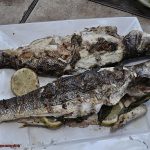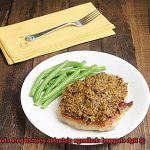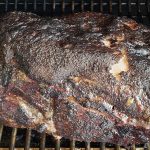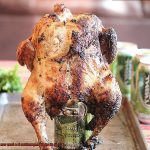Welcome to our blog post all about the brisket-wrapping expertise of the one and only Aaron Franklin.
This BBQ master has a reputation that’s as sizzling as his perfectly cooked meats. When it comes to wrapping brisket, Franklin knows that finding the sweet spot between tender and juicy is key.
And what temperature does he hit for this crucial step? Drumroll please… around 165°F (74°C).
So, let’s get down to the nitty-gritty of Franklin’s method and uncover what makes it so darn good.
Contents
What is Wrapping Brisket?
Wrapping brisket, also known as the Texas crutch, is a technique used by pitmasters to elevate the tenderness and juiciness of this prized cut of meat. Imagine a mouthwatering brisket, slow-cooked for hours, with a perfectly caramelized bark on the outside and a succulent, melt-in-your-mouth interior. That’s the magic of wrapping.
The primary purpose of wrapping brisket is twofold: to speed up the cooking time and to prevent it from drying out. Brisket, being a tough cut, requires a lengthy cooking process to break down the collagen and transform it into tender goodness. However, this slow cooking can also cause the meat to lose moisture and become dry. Wrapping comes to the rescue by creating a moist environment that traps both heat and moisture, resulting in a brisket that is not only tender but also incredibly juicy.
Now, let’s talk about the materials used for wrapping. There are two popular options: foil and butcher paper. Foil provides an airtight seal that locks in all the moisture, giving the brisket a softer texture and a slightly steamed finish. On the other hand, butcher paper allows for some airflow and evaporation, leading to a more bark-like exterior while still retaining that essential juiciness.
The decision to wrap or not depends on personal preference and desired outcome. Some pitmasters prefer not to wrap at all, opting for an extended cooking time that develops maximum bark. Others choose to wrap once the brisket reaches the dreaded stall.
It’s a phenomenon that occurs during cooking when the internal temperature of the brisket plateaus or even drops slightly. This can be frustrating for those eager to serve their guests as it prolongs the cooking time. But fear not. Wrapping can power through the stall by providing insulation and maintaining a consistent temperature until your beautiful brisket reaches its desired doneness.
Now, let’s turn our attention to the maestro of brisket, Aaron Franklin. At his renowned Franklin Barbecue in Austin, Texas, Aaron has perfected the art of smoking brisket. According to his widely shared method, he wraps his brisket when it hits an internal temperature of around 165°F to 170°F (74°C to 77°C). At this point, the brisket has absorbed a significant amount of smoke, developing rich flavors and a robust bark. Wrapping ensures that it stays moist and tender while continuing to cook until it reaches its final internal temperature.
Remember, the decision to wrap at a specific temperature can vary based on personal preferences and factors like equipment and brisket size. So go ahead, experiment, and adjust to find your perfect balance of tenderness and texture.
What Temperature Does Aaron Franklin Wrap His Brisket At?
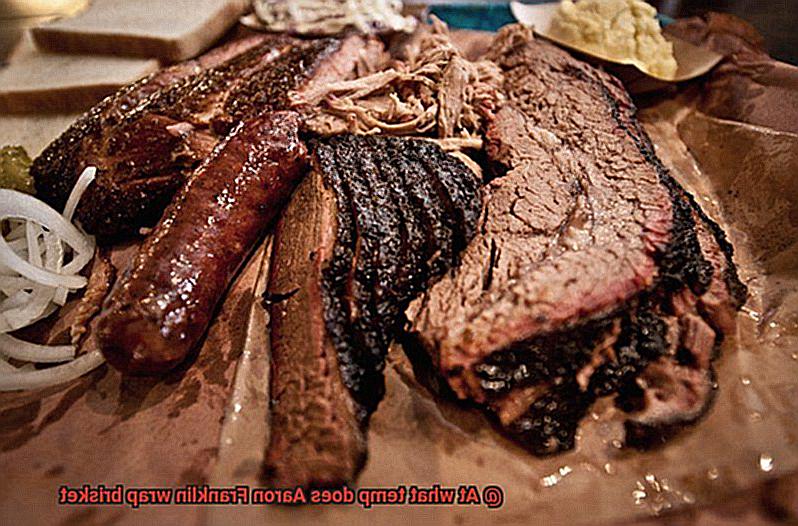
One aspect of his technique that has piqued interest is the temperature at which he wraps his brisket. While Franklin has not explicitly disclosed the exact temperature, insights can be gathered from his teachings and interviews.
The purpose of wrapping the brisket, also known as the “Texas crutch,” is to retain moisture and accelerate cooking time. Franklin typically wraps his brisket when it reaches the stall point, an internal temperature plateau that occurs during cooking. The stall point generally falls between 150°F to 170°F (65°C to 77°C).
Wrapping the brisket at this stage ensures that it retains its moisture and continues to cook through the stall, resulting in tender and juicy meat. It also prevents the surface of the meat from becoming dry or overcooked. While Franklin has not specified the specific temperature, it is believed to be around 160°F to 170°F (71°C to 77°C).
It is important to note that individual techniques may vary among pitmasters, and experimentation is key to finding the perfect recipe. Factors such as brisket size, smoker type, and personal preferences can influence the wrapping temperature.
Factors That Affect the Wrapping Temperature
The wrapping temperature of a brisket is influenced by several key factors. Let’s dive into the details to understand how these factors affect the outcome and how pitmasters like Aaron Franklin achieve exceptional results.
Firstly, meat tenderness plays a crucial role. Franklin believes in cooking the brisket until it reaches the desired level of tenderness before wrapping. This is achieved by cooking the meat at a lower temperature for a longer period. The slow breakdown of collagen results in a tender and juicy brisket that melts in your mouth.
The internal temperature of the meat is another important factor. Franklin suggests cooking the brisket until it reaches an internal temperature of around 165°F (74°C) before considering wrapping. This allows enough time for flavor development and tenderness to be achieved. Wrapping at this stage helps to retain moisture and prevents the meat from drying out.
Bark development, or the flavorful crust on the surface of the brisket, is highly valued in barbecue circles. Franklin prefers to develop a thick and flavorful bark before wrapping. This is done by cooking the brisket uncovered, allowing for better bark formation. Wrapping too early can result in a softer bark or even a steamed texture, which is not desirable.
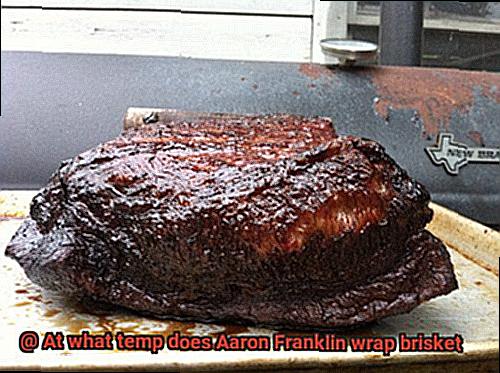
The cooking method used also affects the wrapping temperature. Franklin primarily uses offset smokers, which provide indirect heat and longer cooking times. This method requires lower temperatures and longer durations compared to other methods like grilling or using a gas smoker. The slow cooking process enhances smoke absorption and tenderizes the meat, resulting in exceptional flavor and texture.
Lastly, personal preference plays a role in determining the wrapping temperature. Franklin’s approach is based on his own techniques and experiences as a skilled pitmaster. Other pitmasters may have different preferences based on their own experiences and desired outcomes.
Observing Visual Cues and Texture
When it comes to smoking brisket, Aaron Franklin, the legendary Texas-style BBQ pitmaster, has mastered the art of determining the perfect time to wrap. By relying on visual cues and texture, he ensures that his brisket turns out tender, juicy, and bursting with flavor.
The first visual cue that Franklin looks for is the development of a dark bark or crust on the surface of the brisket. As proteins and sugars react under high heat, they create a tantalizing layer that adds depth and complexity to the meat. This bark also acts as a shield, trapping moisture within and enhancing the overall succulence of the final product.
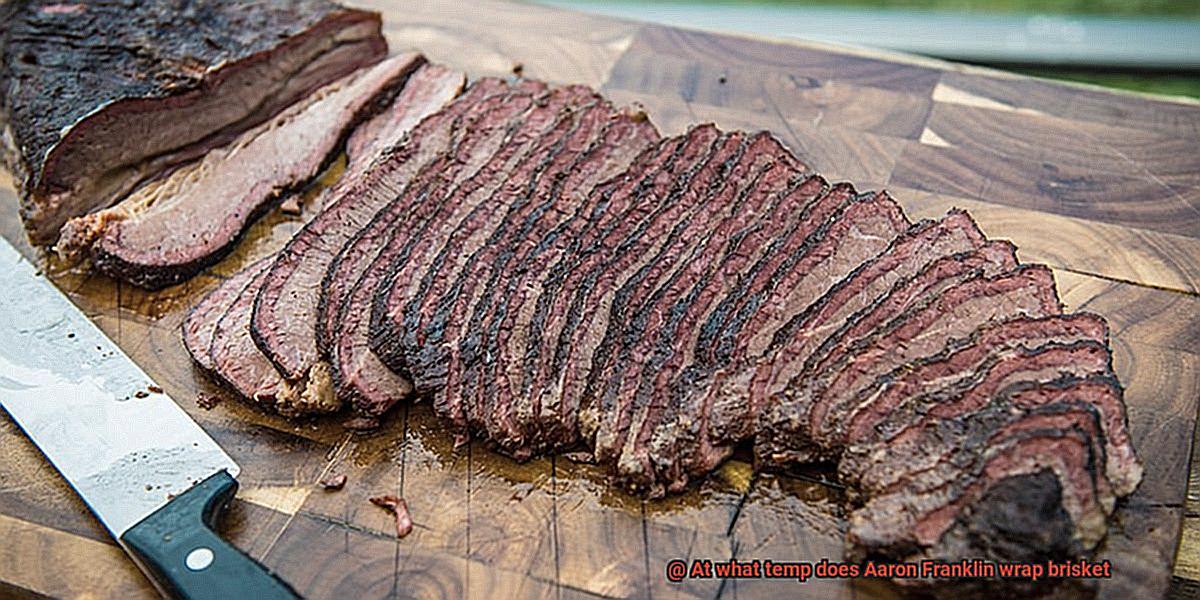
Another visual cue that guides Franklin’s decision to wrap is the rendering of fat on the surface. As the brisket cooks, fat begins to melt and render out, creating a glossy sheen that glistens under the BBQ pit’s smoky embrace. This rendered fat not only contributes to the tenderness of the meat but also infuses it with a rich and buttery flavor.
But visual cues are just part of the equation. Texture plays a significant role in Franklin’s decision-making process as well. The bend test is one technique he relies on to assess when it’s time to wrap. Using tongs, he gently lifts one end of the brisket and observes how it responds. If it offers resistance and remains rigid, indicating an absence of desired tenderness, it’s not yet ready for wrapping. However, if it bends easily and shows signs of looseness, it suggests that it has reached a stage where wrapping can work its magic.
Based on his experience, Franklin typically wraps his brisket when it reaches an internal temperature range of 160 to 170 degrees Fahrenheit (71 to 77 degrees Celsius). At this point, the bark has formed beautifully, and enough fat has rendered to enhance the meat’s succulence.
It’s important to note that each brisket is unique, and various factors, such as size, fat content, and cooking environment, can influence the timing and temperature of wrapping. However, by studying Franklin’s expertise and applying his observation of visual cues and texture, aspiring pitmasters can elevate their own BBQ skills to new heights.
Choosing Between Butcher Paper and Aluminum Foil
When it comes to achieving the perfect wrap for your brisket, the choice between butcher paper and aluminum foil can be a tough one. Each option has its own set of advantages and disadvantages, so let’s compare and contrast them to help you make an informed decision.
Butcher paper is a popular choice among barbecue enthusiasts. One of its key benefits is breathability. Butcher paper allows the meat to breathe, which helps promote smoke penetration and develop a flavorful bark on the outside of the brisket. It also retains enough moisture to keep the brisket juicy and tender, while still maintaining a desirable texture. However, butcher paper has its drawbacks. It is not as effective as aluminum foil at retaining heat, which may result in longer cooking times. Additionally, while it retains some moisture, it doesn’t lock it in as effectively as foil.
On the other hand, aluminum foil is known for its excellent heat retention capabilities. It traps heat effectively, reducing cooking time and ensuring even cooking throughout the brisket. Foil also helps to lock in the juices, resulting in a moist and tender final product. It is also highly versatile and can be easily shaped and molded around the brisket for various cooking methods. However, some barbecue purists argue that wrapping brisket in foil can create a steamed texture rather than the desired smoky and crispy exterior. Foil can also cause the bark to become soft and lose its texture.
So, which option should you choose? If you’re a grilling enthusiast looking for that perfect balance between a smoky crust and tender interior, butcher paper may be your best bet. It allows the meat to breathe, promoting smoke penetration and developing a flavorful bark while still retaining enough moisture to keep the brisket juicy. On the other hand, if you’re pressed for time or prefer a more moist and tender end product, aluminum foil might be your go-to option. It excels at heat retention and moisture locking, resulting in a faster cooking time and a succulent final product.
The Perfect Internal Temperature for Wrapped Brisket
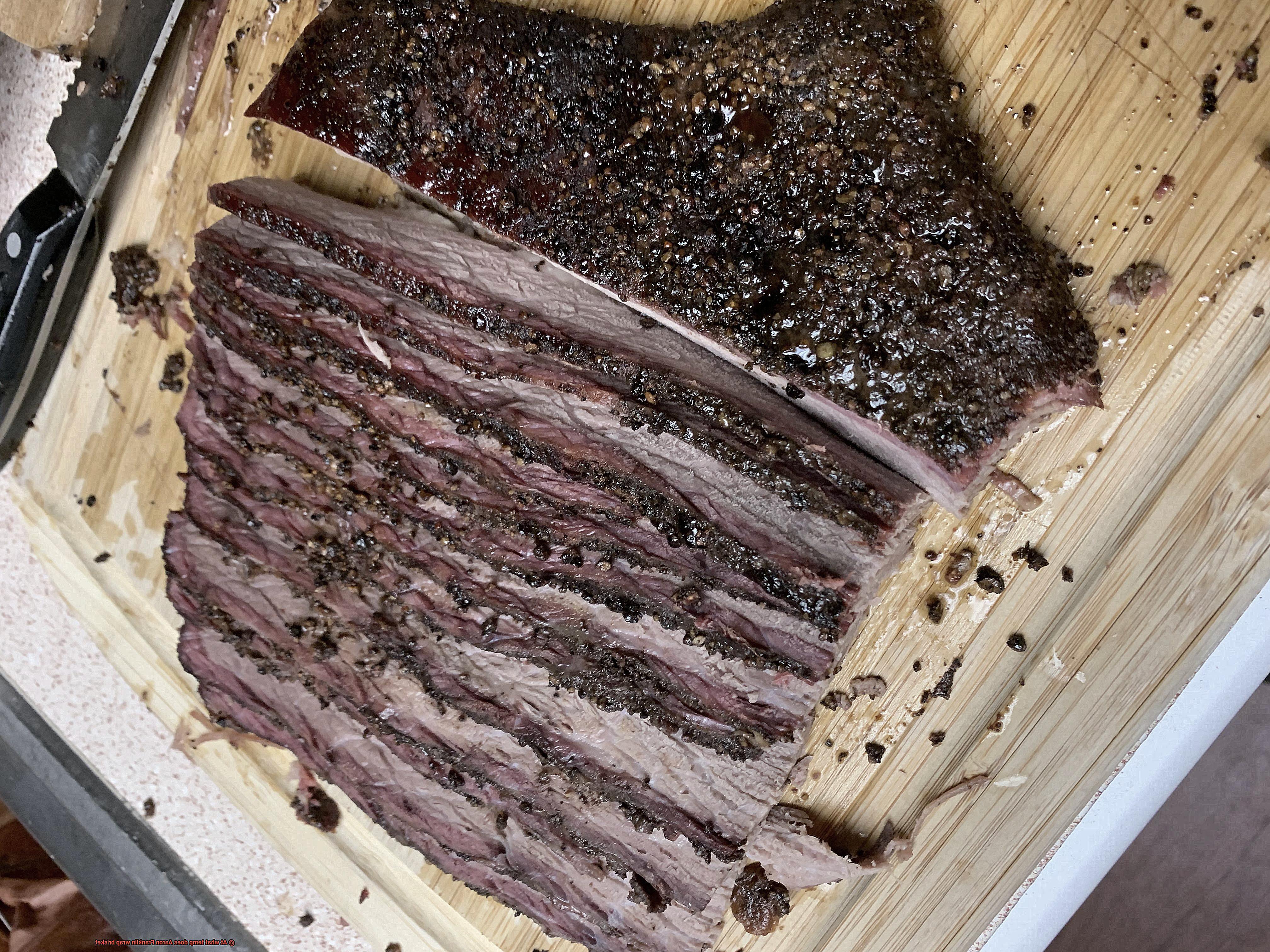
When it comes to achieving the perfect internal temperature for wrapped brisket, Aaron Franklin is the pitmaster extraordinaire to turn to. This grilling guru knows his stuff and has a technique that guarantees mouthwatering results.
The ideal internal temperature for wrapped brisket, according to Franklin, falls between 160-170°F (71-77°C). This temperature range signifies that the brisket has hit the “stall phase.” During this phase, moisture evaporates from the meat’s surface, causing a plateau in temperature. Wrapping the brisket at this point is crucial for speeding up the cooking process. The wrap traps moisture and heat, resulting in a more tender and succulent final product.
To wrap your brisket, Franklin suggests using either aluminum foil or butcher paper. The key is to wrap it tightly, creating a seal that ensures no steam escapes during cooking. This seal locks in all those delicious flavors and juices, infusing the meat with unparalleled taste.
Once wrapped, it’s time to return the brisket to the smoker or grill until it reaches an internal temperature of around 195-203°F (90-95°C). This higher temperature range allows the connective tissues in the brisket to break down further, resulting in that melt-in-your-mouth texture we all crave.
Now, keep in mind that these temperature ranges are just guidelines. Each brisket is unique, so factors like size and fat content can influence cooking times and temperatures. That’s where a reliable meat thermometer comes into play. Keep a watchful eye on that internal temperature to ensure your brisket reaches perfection without overcooking or undercooking.
But wait, we’re not done yet. After your brisket hits its desired internal temperature, resist the temptation to dive right in. Let it rest for at least an hour before slicing. This crucial resting period allows the juices to redistribute within the meat, resulting in a more flavorful and moist end product.
Personalizing Your Wrapping Technique
Now that you have a good understanding of Aaron Franklin’s wrapping technique for grilling brisket, it’s time to learn how to personalize it to suit your own preferences and style. Here are some tips and insights to help you take your brisket to the next level:
- Experiment with different wrapping materials: While Franklin prefers butcher paper for its ability to allow airflow, you can try using aluminum foil or even a combination of both. Each material will yield slightly different results, so don’t be afraid to get creative and find what works best for you.
- Customize your seasoning: Franklin’s simple salt and pepper rub is a classic choice, but feel free to experiment with different seasonings and spices. Whether you prefer a spicy kick or a sweet and smoky flavor, the choice is yours. Just make sure to season the brisket generously before smoking.
- Adjust cooking times and temperatures: Remember that every brisket is unique, so use Franklin’s temperature recommendations as a guide but be prepared to make adjustments based on your specific circumstances. Factors such as the size and thickness of the brisket, the type of smoker or grill you’re using, and even the ambient temperature can all impact cooking times.
- Get creative with wood choices: While Franklin primarily uses oak wood for smoking his brisket, there’s no reason why you can’t explore other options. Woods like hickory, mesquite, or fruitwoods such as apple or cherry can add their own distinct flavors to the meat. Just be mindful of not overpowering the natural flavors of the beef.
- Consider injecting or marinating: To further enhance the moisture and flavor of your brisket, you may want to try injecting it with a marinade or brine before smoking. This can help infuse the meat with additional flavors and keep it juicy throughout the cooking process.
- Practice patience: One of the most crucial aspects of cooking a perfect brisket is allowing it to rest after it’s done. This resting period allows the juices to redistribute and settle, resulting in a more tender and flavorful final product. Aim to let your brisket rest for at least an hour before slicing and serving.
- Experiment with additional ingredients: While Franklin’s technique focuses on the fundamentals, don’t be afraid to add your own personal touch. Consider adding ingredients like onions, garlic, or even a splash of your favorite barbecue sauce to enhance the flavor profile of your brisket.
- Try different wrapping techniques: While Franklin wraps his brisket tightly in butcher paper or aluminum foil, you can experiment with different wrapping techniques to achieve different results. Some pitmasters prefer a looser wrap to allow for more smoke penetration, while others opt for a tighter wrap to retain moisture.
lnRRDSYgdmw” >
Conclusion
In conclusion, Aaron Franklin, the BBQ pitmaster extraordinaire, wraps his brisket at a sizzling temperature of approximately 165°F (74°C). This wrapping technique is like a secret weapon in his culinary arsenal, designed to create a moist and tender masterpiece that will make your taste buds sing.
When the brisket hits the stall point, that magical temperature range of 150°F to 170°F (65°C to 77°C), Franklin knows it’s time to work his wrapping magic. By encasing the meat in either butcher paper or aluminum foil, he creates an environment that locks in heat and moisture, transforming the humble cut into a succulent sensation.
Butcher paper, with its rustic charm, allows just enough airflow and evaporation to give the brisket a bark-like exterior while preserving its juiciness. On the other hand, aluminum foil takes things up a notch by creating an impenetrable seal that ensures every ounce of moisture stays trapped inside. The result? A melt-in-your-mouth texture with a hint of steamy goodness.
It’s important to remember that everyone has their own preferences when it comes to wrapping temperatures. Plus, factors like equipment and brisket size can also play a role in this delicious equation. So don’t be afraid to experiment and find your sweet spot between tenderness and texture.
Aaron Franklin’s expertise in wrapping brisket is nothing short of awe-inspiring. His mastery of achieving perfectly cooked meats with exceptional tenderness and juiciness sets him apart as a true pitmaster virtuoso. Whether you’re an aspiring BBQ maestro or just someone who appreciates good food, let Franklin’s technique be your guiding light on your journey to BBQ greatness.
So go forth and wrap your briskets with confidence, knowing that you’re following in the footsteps of one of the best in the business.


